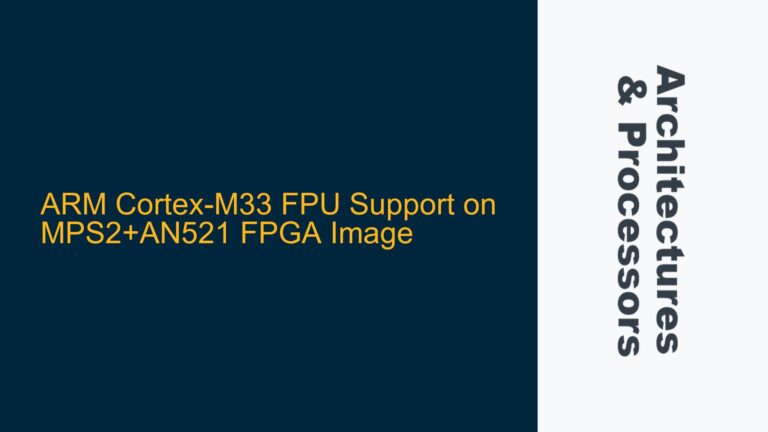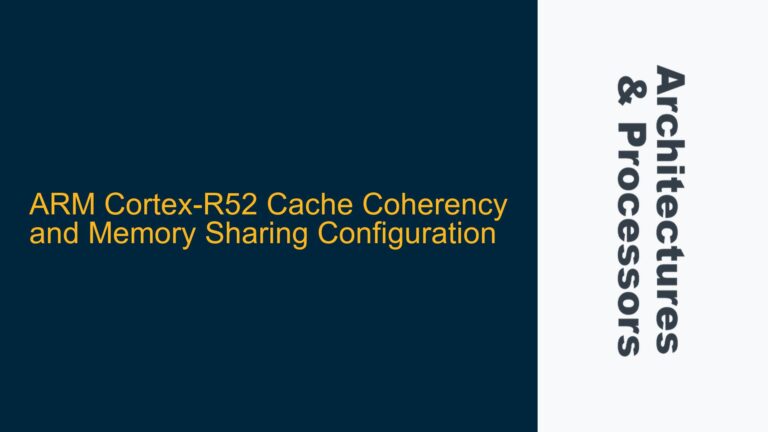ARM Cortex-A57 Multicontroller System Design Challenges
Designing a multicontroller system using ARM Cortex-A57 processors involves addressing several architectural and operational challenges. The Cortex-A57 is a high-performance processor core designed for applications requiring significant computational power, such as networking, storage, and high-end embedded systems. When multiple Cortex-A57 cores are used in a system, efficient communication and resource sharing become critical to achieving optimal performance and reliability.
The primary challenge in a multicontroller system is ensuring that all Cortex-A57 cores can communicate with each other at high speeds while minimizing latency and avoiding resource contention. This requires a deep understanding of the ARM architecture, particularly the memory hierarchy, cache coherency mechanisms, and inter-core communication protocols. Additionally, the system must be designed to handle shared resources such as memory, peripherals, and I/O interfaces without causing bottlenecks or race conditions.
One of the key considerations in a multicontroller system is the choice of communication protocol. The Cortex-A57 supports several inter-processor communication mechanisms, including shared memory, message passing, and hardware-assisted communication channels. Each of these mechanisms has its own advantages and trade-offs, and the choice of protocol will depend on the specific requirements of the application, such as latency, bandwidth, and scalability.
Another critical aspect of multicontroller system design is resource sharing. In a system with multiple Cortex-A57 cores, resources such as memory, peripherals, and I/O interfaces must be shared efficiently to avoid contention and ensure that each core can access the resources it needs without unnecessary delays. This requires careful planning of the memory map, as well as the use of synchronization mechanisms such as semaphores, mutexes, and barriers to manage access to shared resources.
Cache Coherency and Memory Synchronization in Multicontroller Systems
Cache coherency and memory synchronization are among the most complex issues in multicontroller systems using ARM Cortex-A57 processors. The Cortex-A57 features a sophisticated cache hierarchy, including L1 and L2 caches, which are designed to reduce memory access latency and improve performance. However, in a multicontroller system, maintaining cache coherency across multiple cores is essential to ensure that all cores have a consistent view of memory.
The ARM Cortex-A57 implements the ARMv8-A architecture, which includes support for cache coherency through the AMBA 4 ACE (AXI Coherency Extensions) protocol. This protocol allows multiple cores to share a coherent view of memory, ensuring that changes made by one core are visible to all other cores in the system. However, achieving cache coherency in practice requires careful management of cache lines, memory barriers, and synchronization primitives.
One common issue in multicontroller systems is the omission of memory barriers, which can lead to subtle bugs and performance bottlenecks. Memory barriers are instructions that enforce ordering constraints on memory operations, ensuring that all previous memory accesses are completed before subsequent accesses are performed. In a multicontroller system, memory barriers are essential to prevent race conditions and ensure that all cores see a consistent view of memory.
Another potential cause of cache coherency issues is improper cache invalidation or flushing. When a core modifies a memory location that is cached by other cores, it must ensure that the modified data is written back to main memory and that the caches of other cores are invalidated. Failure to do so can result in stale data being read by other cores, leading to incorrect behavior and difficult-to-debug issues.
To address these challenges, developers must implement robust cache management strategies, including the use of data synchronization barriers (DSBs) and instruction synchronization barriers (ISBs) to enforce memory ordering, as well as cache maintenance operations such as invalidate, clean, and flush to manage cache coherency. Additionally, developers should carefully design the memory map and use hardware-assisted coherency mechanisms where available to minimize the overhead of maintaining cache coherency.
Implementing High-Speed Communication and Resource Sharing in Cortex-A57 Systems
Implementing high-speed communication and resource sharing in a multicontroller system based on ARM Cortex-A57 processors requires a combination of hardware and software techniques. The following steps outline a comprehensive approach to designing and optimizing such a system:
Step 1: Define the Communication Protocol
The first step in designing a multicontroller system is to define the communication protocol that will be used between the Cortex-A57 cores. The choice of protocol will depend on the specific requirements of the application, such as latency, bandwidth, and scalability. For high-speed communication, shared memory is often the preferred approach, as it allows cores to exchange data with minimal overhead. However, shared memory requires careful management of cache coherency and memory synchronization, as discussed earlier.
In addition to shared memory, message passing can be used for inter-core communication. Message passing involves sending data between cores using a dedicated communication channel, such as a mailbox or hardware FIFO. This approach can be more scalable than shared memory, as it avoids the need for complex cache coherency mechanisms. However, message passing typically incurs higher latency than shared memory, making it less suitable for applications requiring real-time communication.
Step 2: Design the Memory Map
The memory map is a critical component of any multicontroller system, as it defines how memory and peripherals are accessed by each core. In a Cortex-A57 system, the memory map should be designed to minimize contention and ensure that each core has efficient access to the resources it needs. This may involve partitioning memory into regions that are private to each core, as well as shared regions that can be accessed by multiple cores.
When designing the memory map, it is important to consider the cacheability of each memory region. Memory regions that are frequently accessed by multiple cores should be marked as cacheable to reduce latency, while regions that are rarely shared may be marked as non-cacheable to simplify cache management. Additionally, the memory map should be designed to support hardware-assisted coherency mechanisms, such as the AMBA 4 ACE protocol, to minimize the overhead of maintaining cache coherency.
Step 3: Implement Synchronization Mechanisms
Synchronization mechanisms are essential for managing access to shared resources in a multicontroller system. In a Cortex-A57 system, synchronization can be achieved using a combination of hardware and software techniques. Hardware synchronization mechanisms, such as atomic operations and hardware locks, can be used to implement low-level synchronization primitives, such as spinlocks and mutexes. These primitives can then be used to implement higher-level synchronization mechanisms, such as semaphores and barriers.
In addition to hardware synchronization, software techniques such as message passing and event-driven programming can be used to coordinate the activities of multiple cores. For example, a producer-consumer model can be used to manage access to a shared buffer, with one core producing data and another core consuming it. This approach can be implemented using message passing or shared memory, depending on the specific requirements of the application.
Step 4: Optimize Cache Coherency and Memory Access
Optimizing cache coherency and memory access is critical to achieving high performance in a multicontroller system. In a Cortex-A57 system, this involves implementing robust cache management strategies, including the use of data synchronization barriers (DSBs) and instruction synchronization barriers (ISBs) to enforce memory ordering, as well as cache maintenance operations such as invalidate, clean, and flush to manage cache coherency.
Additionally, developers should consider using hardware-assisted coherency mechanisms, such as the AMBA 4 ACE protocol, to minimize the overhead of maintaining cache coherency. These mechanisms allow multiple cores to share a coherent view of memory without requiring explicit cache maintenance operations, reducing the complexity of the software and improving performance.
Step 5: Test and Validate the System
The final step in implementing a multicontroller system is to test and validate the system to ensure that it meets the performance and reliability requirements of the application. This involves testing the system under a variety of conditions, including high load, low load, and fault conditions, to identify and address any performance bottlenecks or synchronization issues.
Testing should include both functional testing, to verify that the system behaves correctly under normal conditions, and stress testing, to ensure that the system can handle extreme conditions without failing. Additionally, developers should use profiling tools to identify performance bottlenecks and optimize the system for maximum throughput and minimum latency.
In conclusion, designing and implementing a multicontroller system using ARM Cortex-A57 processors requires a deep understanding of the ARM architecture, as well as careful planning and optimization of communication, resource sharing, and cache coherency. By following the steps outlined above, developers can build high-performance, reliable multicontroller systems that meet the demands of even the most challenging applications.





